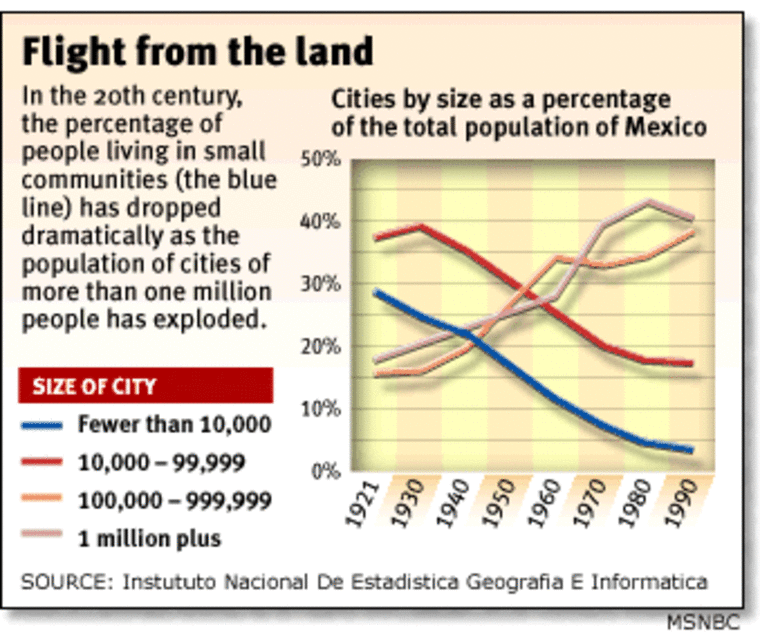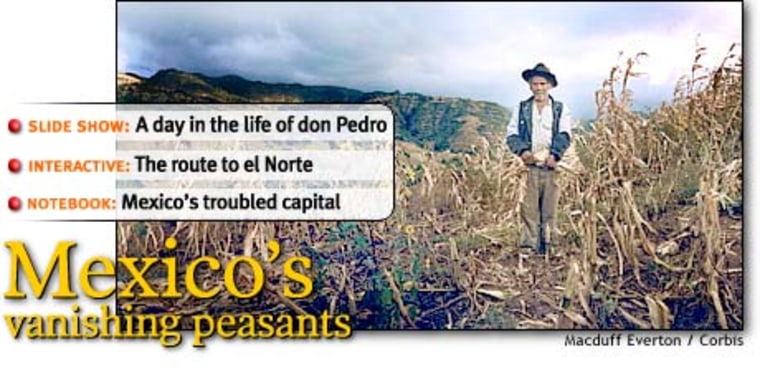For decades, a broad, deep human river of Mexicans has been flowing out of the countryside and coursing into the cities, toward northern Mexico and into the United States. Modern agribusiness, economic troubles and the Zapatista uprising in Chiapas all add to the currents washing people off the land, eroding rural economies and traditional communities centuries in the making. Can the process, which bloats urban slums and feeds illegal immigration, be reversed?
As the mist thins, the steep wooded ridges of the Sierra Juárez loom into the morning. Just outside Talea de Castro, a hillside town of about 3,000, Pedro Cruz López, known locally as don Pedro, and his foreman, Hipólito Cruz Chavez, are measuring land for a new irrigation system for López’s coffee farm.
Don Pedro, 72, has spent his life growing and trading coffee in Talea and surrounding towns. His sons have left: Tino for the provincial capital, Oaxaca; Lucas for Los Angeles. Hipólito, the 50-year-old foreman, also has tried moving to Mexico City, but returned when he found life there too turbulent.
Coffee farming is a grueling business. “The work rules our lives,” says don Pedro. “As much as you may want to rest, the work doesn’t stop.”
But it has allowed him to make a decent living by local standards. Starting in his 30s with nothing, and with his young wife dead and two small sons to care for, don Pedro now owns eight parcels of land and hires a few workers to help him during the harvest. Unlike many farmers, he can afford the plastic pipe to carry the water from a natural spring to the coffee groves.
“In the communities that can’t grow coffee, you can’t survive,” says Lucas Cruz. “People have been emigrating from them for 40 years. But in the coffee-growing towns like this one, not so many people leave. There’s no hunger, you have the basics you need to get by, thanks to the coffee.”
Small farming economy
Oaxacan analyst Juan Rodríguez Cabrera concurs: “Emigration has less impact on coffee growing areas. Fewer people leave because there’s a little bit more opportunity.”

Since World War II, the world’s developing nations - prodded by rich donor states - generally reacted to the kinds of migration problems Mexico faced with gigantic public works projects that ultimately did little to improve local realities. Today, the success of small enterprises - farms, factories or other cottage industries - is changing opinions on how to best tackle the problem.
Over the years, Mexico’s ruling party, the PRI, has spent billions on Pharaonic public works projects in neighboring Chiapas province. Perhaps the most notorious is the Opera House at San Cristobal de las Casas, an $11 million project that was to bring world-class performances to the provincial capital of a state riddled by hunger and insurgency.
These large-scale efforts at social engineering are no longer in vogue, having failed dramatically to stem the rural hemorrhage. From 1921 to 1990, the percentage of the population living in small towns went from 30 percent to less than 5 percent. At the same time, the percentage of the country’s population living in cities with more than 1 million people increased from 17 percent to nearly 45 percent.
Remote Talea escaped such attention. Partly as a result, the small farm economy that many see as best suited to the region has survived. Not only do many coffee farmers in Talea make enough so they don’t have to emigrate, but during the coffee season, people from nearby areas even come to Talea to work on the harvest. From December to March, coffee pickers can make more than three times the minimum wage for the city of Oaxaca.
In contrast to other export crops, 70 percent of Mexican coffee is produced by small growers, most in the poor states of southern Mexico.Although international prices rise and fall like a roller coaster, the long-term average has been high enough to assure cafetaleros a modest living.

For some growers, organic coffee holds out the promise of better prices and a healthier local environment. Don Pedro hasn’t used pesticides or chemical fertilizers for six years, and is considering having his coffee certified as organic - something that will help him market it to increasingly discerning customers abroad.
Nevertheless, many people still emigrate from Talea and surrounding towns. Low-income families often go to nearby agricultural areas or cities to seek work. And it’s not just the poorest people who leave: middle-class Mexicans, too, have been buffeted by the waves of economic crisis. To emigrate to the north of Mexico or the United States requires a certain amount of resources, and those who have them often go with entrepreneurial goals.
According to Lucas Cruz, “Some people leave to make a little bit of money, then they come back, buy a coffee grove and go on with their lives. I can think of four or five people from here who have done that.”
Preference for home
Arturo Santiago, a farmer in nearby Tanetze, is one such returnee. In the 1980s, he spent a year working as a gardener in Los Angeles, earning the nest egg that would let him build houses for his four sons, as his Zapotec tribal custom decrees. He’s still finishing the four houses and remodeling his own home, working with don Pedro’s son Tino, an architect in Oaxaca city.

El Rincón, the area around Talea, receives enough rain and is high enough in altitude to grow coffee. Some other parts of the state, however, cannot grow coffee or much of anything else: they are too arid and their soil is too depleted. The Mixteca area in western Oaxaca is famous for exporting its people: many of its villages have become near ghost towns, with only old people and mothers with small children staying behind. The economy there depends on remittances from the United States.
From the Mixteca, as from many other regions of Mexico, generations have left for greener pastures. Oaxacan farm workers travel a well-worn path up through the valleys of Sinaloa, Sonora and Baja California, where corporate farms grow vegetables for export, across the border to Los Angeles and the central valleys of California. Some make it as far north as Oregon and Washington.
Ironically, Mexican government policies meant to keep the agricultural economy growing have contributed to the migration by pushing many small farmers off the land. Changes in the agrarian reform law and cutbacks in credit and technical support have pulled the rug out from under small growers, favoring instead large-scale farming for export. As the prices of campesinos’ crops have fallen, their cost of living has risen.
The North American Free Trade Agreement and the 1994 devaluation of the peso have also put pressure on the rural population, explains geographer Jeanine Klaver, by encouraging the privatization of agriculture and the liberalization of trade in agricultural products. Because of this restructuring of the economy, she says, “in the short to medium run, migration from Mexico to the U.S. is likely to increase.”
Peter Costantini is a Seattle-based journalist who specializes in Latin American affairs.
